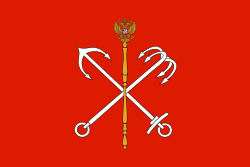Peter the Great
| Peter the Great | |||||
|---|---|---|---|---|---|
 Portrait by Paul Delaroche | |||||
| Emperor of All Russia | |||||
| Reign |
2 November 1721 – 8 February 1725 | ||||
| Successor | Catherine I | ||||
| Tsar of All Russia | |||||
| Reign | 7 May 1682 – 2 November 1721 | ||||
| Coronation | 25 June 1682 | ||||
| Predecessor | Feodor III | ||||
| Co-monarch | Ivan V | ||||
| Born |
9 June 1672 Moscow, Tsardom of Russia | ||||
| Died |
8 February 1725 (aged 52) Saint Petersburg, Russian Empire | ||||
| Burial | Peter and Paul Cathedral | ||||
| Consort | |||||
| Issue among others | |||||
| |||||
| House | Romanov | ||||
| Father | Alexis of Russia | ||||
| Mother | Natalya Naryshkina | ||||
| Religion | Russian Orthodoxy | ||||
| Signature |
| ||||
Peter the Great (Russian: Пётр Вели́кий, tr. Pyotr Velikiy; IPA: [ˈpʲɵtr vʲɪˈlʲikʲɪj]), Peter I (Russian: Пётр I, tr. Pyotr I; IPA: [ˈpʲɵtr ˈpʲɛrvɨj]) or Peter Alexeyevich (Russian: Пётр Алексе́евич; IPA: [ˈpʲɵtr ɐlʲɪˈksʲejɪvʲɪtɕ]; 9 June [O.S. 30 May] 1672 – 8 February [O.S. 28 January] 1725)[lower-alpha 1] ruled the Tsardom of Russia and later the Russian Empire from 7 May (O.S. 27 April) 1682 until his death, jointly ruling before 1696 with his elder half-brother, Ivan V. Through a number of successful wars he expanded the Tsardom into a much larger empire that became a major European power. He led a cultural revolution that replaced some of the traditionalist and medieval social and political systems with ones that were modern, scientific, westernized, and based on The Enlightenment.[1] Peter's reforms made a lasting impact on Russia and many institutions of Russian government trace their origins to his reign.
Title
The imperial title of Peter the Great was the following:[2]
By the grace of God, the most excellent and great sovereign prince Pyotr Alekseevich the ruler all the Russias: of Moscow, of Kiev, of Vladimir, of Novgorod, Tsar of Kazan, Tsar of Astrakhan and Tsar of Siberia, sovereign of Pskov, great prince of Smolensk, Tversk, Yugorsk, Permsky, Vyatsky, Bulgarsky and others, sovereign and great prince of Novgorod Nizovsky lands, Chernigovsky, of Ryazan, of Rostov, Yaroslavl, Belozersky, Udorsky, Kondiisky and the sovereign of all the northern lands, and the sovereign of the Iverian lands, of the Kartlian and Georgian Kings, of the Kabardin lands, of the Circassian and Mountain princes and many other states and lands western and eastern here and there and the successor and sovereign and ruler.
Life
Early years
From an early age, Peter's education (commissioned by his father, Tsar Alexis I) was put in the hands of several tutors, most notably Nikita Zotov, Patrick Gordon, and Paul Menesius. On 29 January 1676, Tsar Alexis died, leaving the sovereignty to Peter's elder half-brother, the weak and sickly Feodor III. Throughout this period, the government was largely run by Artamon Matveev, an enlightened friend of Alexis, the political head of the Naryshkin family and one of Peter's greatest childhood benefactors.
This position changed when Feodor died in 1682. As Feodor did not leave any children, a dispute arose between the Miloslavsky family (Maria Miloslavskaya was the first wife of Alexis I) and Naryshkin family (Natalya Naryshkina was the second wife) over who should inherit the throne. Peter's other half-brother, Ivan V, was next in line for the throne, but he was chronically ill and of infirm mind. Consequently, the Boyar Duma (a council of Russian nobles) chose the 10-year-old Peter to become Tsar with his mother as regent.
This arrangement was brought before the people of Moscow, as ancient tradition demanded, and was ratified. Sophia Alekseyevna, one of Alexis' daughters from his first marriage, led a rebellion of the Streltsy (Russia's elite military corps) in April–May 1682. In the subsequent conflict some of Peter's relatives and friends were murdered, including Matveev, and Peter witnessed some of these acts of political violence.[3]
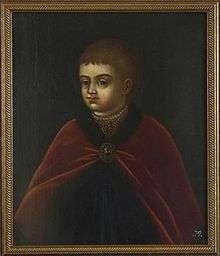
The Streltsy made it possible for Sophia, the Miloslavskys (the clan of Ivan) and their allies, to insist that Peter and Ivan be proclaimed joint Tsars, with Ivan being acclaimed as the senior. Sophia acted as regent during the minority of the sovereigns and exercised all power. For seven years, she ruled as an autocrat. A large hole was cut in the back of the dual-seated throne used by Ivan and Peter. Sophia would sit behind the throne and listen as Peter conversed with nobles, while feeding him information and giving him responses to questions and problems. This throne can be seen in the Kremlin Armoury in Moscow.
Peter was not particularly concerned that others ruled in his name. He engaged in such pastimes as shipbuilding and sailing, as well as mock battles with his toy army. Peter's mother sought to force him to adopt a more conventional approach, and arranged his marriage to Eudoxia Lopukhina in 1689.[4] The marriage was a failure, and ten years later Peter forced his wife to become a nun and thus freed himself from the union.
By the summer of 1689, Peter planned to take power from his half-sister Sophia, whose position had been weakened by two unsuccessful Crimean campaigns. When she learned of his designs, Sophia conspired with the leaders of the Streltsy, who continually aroused disorder and dissent. Peter, warned by the Streltsy, escaped in the middle of the night to the impenetrable monastery of Troitse-Sergiyeva Lavra; there he slowly gathered adherents who perceived he would win the power struggle. Sophia was eventually overthrown, with Peter I and Ivan V continuing to act as co-tsars. Peter forced Sophia to enter a convent, where she gave up her name and her position as a member of the royal family.
Still, Peter could not acquire actual control over Russian affairs. Power was instead exercised by his mother, Natalya Naryshkina. It was only when Nataliya died in 1694 that Peter became an independent sovereign.[5] Formally, Ivan V remained a co-ruler with Peter, although he was ineffective. Peter became the sole ruler when Ivan died in 1696.
Peter grew to be extremely tall as an adult, especially for the time period. Standing at 6 ft 8 in (203 cm) in height, the Russian tsar was literally head and shoulders above his contemporaries both in Russia and throughout Europe.[5] Peter, however, lacked the overall proportional heft and bulk generally found in a man that size. Both Peter's hands and feet were small, and his shoulders were narrow for his height; likewise, his head was small for his tall body. Added to this were Peter's noticeable facial tics, and he may have suffered from petit mal, a form of epilepsy.[6]
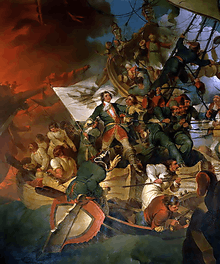
Early reign
Peter implemented sweeping reforms aimed at modernizing Russia.[7] Heavily influenced by his advisors from Western Europe, Peter reorganized the Russian army along modern lines and dreamed of making Russia a maritime power. He faced much opposition to these policies at home, but brutally suppressed any and all rebellions against his authority: Streltsy, Bashkirs, Astrakhan, and the greatest civil uprising of his reign, the Bulavin Rebellion.
Peter implemented social modernization in an absolute manner by introducing French and western dress to his court and requiring courtiers, state officials, and the military to shave their beards and adopt modern clothing styles.[8] One means of achieving this end was the introduction of taxes for long beards and robes in September 1698.[9]
To improve his nation's position on the seas, Peter sought to gain more maritime outlets. His only outlet at the time was the White Sea at Arkhangelsk. The Baltic Sea was at the time controlled by Sweden in the north, while the Black Sea and the Caspian Sea were controlled by the Ottoman Empire and Safavid Empire respectively in the south.
Peter attempted to acquire control of the Black Sea; to do so he would have to expel the Tatars from the surrounding areas. As part of an agreement with Poland which ceded Kiev to Russia, Peter was forced to wage war against the Crimean Khan and against the Khan's overlord, the Ottoman Sultan. Peter's primary objective became the capture of the Ottoman fortress of Azov, near the Don River. In the summer of 1695 Peter organized the Azov campaigns to take the fortress, but his attempts ended in failure.
Peter returned to Moscow in November 1695 and began building a large navy. He launched about thirty ships against the Ottomans in 1696, capturing Azov in July of that year. On 12 September 1698, Peter officially founded the first Russian Navy base, Taganrog.
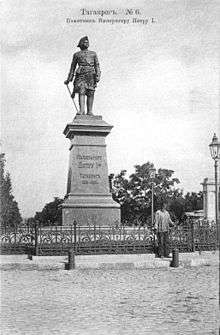
Grand Embassy
Peter knew that Russia could not face the Ottoman Empire alone. In 1697 he traveled incognito to Europe on an 18-month journey with a large Russian delegation–the so-called "Grand Embassy". Since he was far taller than almost anyone else, his fake name allowed him to escape social and diplomatic events, but did not fool anyone of importance. One goal was to seek the aid of the European monarchs. Peter's hopes were dashed; France was a traditional ally of the Ottoman Sultan, and Austria was eager to maintain peace in the east while conducting its own wars in the west. Peter, furthermore, had chosen the most inopportune moment; the Europeans at the time were more concerned about who would succeed the childless Spanish King Charles II than about fighting the Ottoman Sultan.[4]
The "Grand Embassy", although failing to complete the mission of creating an anti-Ottoman alliance, continued. While visiting the Netherlands, Peter learned much about life in Western Europe. He studied shipbuilding in Zaandam (the house he lived in is now a museum, the Czar Peter House) and Amsterdam, where he visited, among others, the upper-class de Wilde family.
Jacob de Wilde, a collector-general with the Admiralty of Amsterdam, had a well-known collection of art and coins, and de Wilde's daughter Maria de Wilde made an engraving of the meeting between Peter and her father, providing visual evidence of "the beginning of the West European classical tradition in Russia".[10] According to Roger Tavernier, Peter the Great later acquired de Wilde's collection.[11]
Thanks to the mediation of Nicolaas Witsen, mayor of Amsterdam and expert on Russia, the Tsar was given the opportunity to gain practical experience in the largest shipyard in the world, belonging to the Dutch East India Company, for a period of four months. The Tsar helped with the construction of an East Indiaman especially laid down for him: Peter and Paul.
During his stay the Tsar engaged many skilled workers such as builders of locks, fortresses, shipwrights, and seamen—including Cornelis Cruys, a vice-admiral who became, under Franz Lefort, the Tsar's advisor in maritime affairs. Peter later put his knowledge of shipbuilding to use in helping build Russia's navy.[12]
Peter paid a visit to Frederik Ruysch, who taught him how to draw teeth and catch butterflies. Ludolf Bakhuysen, a painter of seascapes and Jan van der Heyden the inventor of the fire hose, received Peter, who was keen to learn and pass on his knowledge to his countrymen. On 16 January 1698 Peter organized a farewell party and invited Johan Huydecoper van Maarsseveen, who had to sit between Lefort and the Tsar and drink.
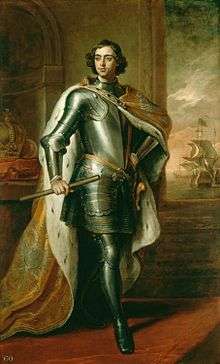
In England Peter met with King William III, visited Greenwich and Oxford, was painted by Sir Godfrey Kneller, and saw a Royal Navy Fleet Review at Deptford. He travelled to the city of Manchester to learn the techniques of city-building he would later use to great effect at Saint Petersburg. The Embassy next went to Leipzig, Dresden, and Vienna. He spoke with Augustus II of Poland and Leopold I, Holy Roman Emperor.[13]
Peter's visit was cut short in 1698, when he was forced to rush home by a rebellion of the Streltsy. The rebellion was easily crushed before Peter returned home from England; of the Tsar's troops, only one was killed. Peter nevertheless acted ruthlessly towards the mutineers. Over 1,200 of the rebels were tortured and executed, and Peter ordered that their bodies be publicly exhibited as a warning to future conspirators.[14] The Streltsy were disbanded, and the individual they sought to put on the Throne—Peter's half-sister Sophia—was forced to become a nun.
In 1698 Peter sent a delegation to Malta under boyar Boris Sheremetev, to observe the training and abilities of the Knights of Malta and their fleet. Sheremetev investigated the possibility of future joint ventures with the Knights, including action against the Turks and the possibility of a future Russian naval base.[15]
Peter's visits to the West impressed upon him the notion that European customs were in several respects superior to Russian traditions. He commanded all of his courtiers and officials to wear European clothing and cut off their long beards, causing his Boyars, who were very fond of their beards, great upset.[16] Boyars who sought to retain their beards were required to pay an annual beard tax of one hundred rubles.
Peter also sought to end arranged marriages, which were the norm among the Russian nobility, because he thought such a practice was barbaric and led to domestic violence, since the partners usually resented each other.[17]
In 1699 Peter changed the date of the celebration of the new year from 1 September to 1 January. Traditionally, the years were reckoned from the purported creation of the World, but after Peter's reforms, they were to be counted from the birth of Christ. Thus, in the year 7207 of the old Russian calendar, Peter proclaimed that the Julian Calendar was in effect and the year was 1700.[18]
Great Northern War
Peter made a temporary peace with the Ottoman Empire that allowed him to keep the captured fort of Azov, and turned his attention to Russian maritime supremacy. He sought to acquire control of the Baltic Sea, which had been taken by the Swedish Empire a half-century earlier. Peter declared war on Sweden, which was at the time led by King Charles XII. Sweden was also opposed by Denmark-Norway, Saxony, and the Polish-Lithuanian Commonwealth.
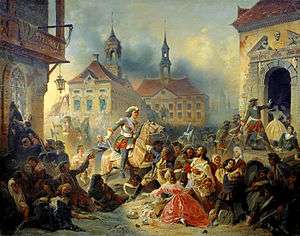
Russia was ill-prepared to fight the Swedes, and their first attempt at seizing the Baltic coast ended in disaster at the Battle of Narva in 1700. In the conflict, the forces of Charles XII used a blinding snowstorm to their advantage. After the battle, Charles XII decided to concentrate his forces against the Polish-Lithuanian Commonwealth, which gave Peter time to reorganize the Russian army.
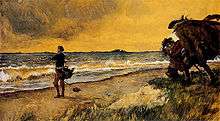
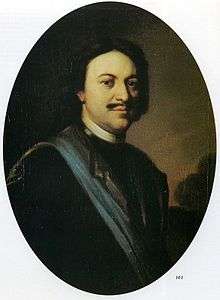
As the Poles fought against the Swedes, Peter founded the city of Saint Petersburg (Germanically named after Saint Peter the Apostle) in Ingermanland (province of Swedish empire, which he had captured) in 1703. He forbade the building of stone edifices outside Saint Petersburg, which he intended to become Russia's capital, so that all stonemasons could participate in the construction of the new city.
Following several defeats, Polish King Augustus II the Strong abdicated in 1706. Swedish king Charles XII turned his attention to Russia, invading it in 1708. After crossing into Russia, Charles defeated Peter at Golovchin in July. In the Battle of Lesnaya, Charles suffered his first loss after Peter crushed a group of Swedish reinforcements marching from Riga. Deprived of this aid, Charles was forced to abandon his proposed march on Moscow.[19]
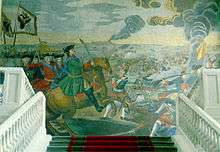
Charles XII refused to retreat to Poland or back to Sweden, instead invading Ukraine. Peter withdrew his army southward, destroying along the way any property that could assist the Swedes. Deprived of local supplies, the Swedish army was forced to halt its advance in the winter of 1708–1709. In the summer of 1709, they resumed their efforts to capture Ukraine, culminating in the Battle of Poltava on 27 June. The battle was a decisive defeat for the Swedish forces, ending Charles' campaign in Ukraine and forcing him into exile in the Ottoman Empire. In Poland, Augustus II was restored as King.
Peter, overestimating the support he would receive from his Balkan allies, attacked the Ottoman Empire, initiating the Russo-Turkish War of 1710.[20] Peter's campaign in the Ottoman Empire was disastrous, and in the ensuing peace treaty (Treaty of Pruth), Peter was forced to return the Black Sea ports he had seized in 1697.[20] In return, the Sultan expelled Charles XII.
Normally, the Boyar Duma would have exercised power during his absence. Peter, however, mistrusted the boyars; he instead abolished the Duma and created a Senate of ten members. The Senate was founded as the highest state institution to supervise all judicial, financial and administrative affairs.
Originally established only for the time of the monarch's absence, the Senate became a permanent body after his return. A special high official the Ober-Procurator, served as the link between the ruler and the senate and acted, in Peter own words, as "the sovereign's eye". Without his signature no Senate decision could go into effect; the Senate became one of the most important institutions of Imperial Russia.[21]
Peter's northern armies took the Swedish province of Livonia (the northern half of modern Latvia, and the southern half of modern Estonia), driving the Swedes into Finland. In 1714 the Russian fleet won the Battle of Gangut. Most of Finland was occupied by the Russians.
In 1716 and 1717, the Tsar revisited the Netherlands, and went to see Herman Boerhaave. He continued his travel to the Austrian Netherlands and France. The Tsar's navy was so powerful that the Russians could penetrate Sweden. Peter also obtained the assistance of the Electorate of Hanover and the Kingdom of Prussia.
Still, Charles XII refused to yield, and not until his death in battle in 1718 did peace become feasible. After the battle near Åland, Sweden made peace with all powers but Russia by 1720. In 1721 the Treaty of Nystad ended what became known as the Great Northern War. Russia acquired Ingria, Estonia, Livonia, and a substantial portion of Karelia. In turn, Russia paid two million Riksdaler and surrendered most of Finland. The Tsar retained some Finnish lands close to Saint Petersburg, which he had made his capital in 1712.[22]
Later years

Peter's last years were marked by further reform in Russia. On 22 October 1721, soon after peace was made with Sweden, he was officially proclaimed Emperor of All Russia. Some proposed that he take the title Emperor of the East, but he refused. Gavrila Golovkin, the State Chancellor, was the first to add "the Great, Father of His Country, Emperor of All the Russias" to Peter's traditional title Tsar following a speech by the archbishop of Pskov in 1721.
Peter's imperial title was recognized by Augustus II of Poland, Frederick William I of Prussia, and Frederick I of Sweden, but not by the other European monarchs. In the minds of many, the word emperor connoted superiority or pre-eminence over kings. Several rulers feared that Peter would claim authority over them, just as the Holy Roman Emperor had claimed suzerainty over all Christian nations.
In 1718 Peter investigated why the ex Swedish province of Livonia was so orderly. He discovered that the Swedes spent as much administering Livonia (300 times smaller than his empire) as he spent on the entire Russian bureaucracy. He was forced to dismantle the province's government.[23]
After 1718, Peter established colleges in place of the old central agencies of government. The new agencies were originally nine in number: Foreign affairs, war, navy, expense, income, justice, inspection. Later others were added. Each college consisted of a president, a vice-president and a number of councilors, assessors in addition to one procurator. Some foreigners were included in various colleges but not as president. Decisions depended on the majority vote, Peter believed he did not have enough loyal and talented persons to put them in full charge of the different departments. Peter preferred to rely on groups of individuals who would keep check on one another.[24]
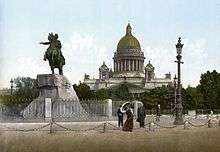
In 1722 Peter created a new order of precedence known as the Table of Ranks. Formerly, precedence had been determined by birth. To deprive the Boyars of their high positions, Peter directed that precedence should be determined by merit and service to the Emperor. The Table of Ranks continued to remain in effect until the Russian monarchy was overthrown in 1917.
Peter decided that all of the children of the nobility should have some early education, especially in the areas of sciences. Therefore, on 28 February 1714, he issued a decree calling for compulsory education, which dictated that all Russian 10- to 15-year-old children of the nobility, government clerks, and lesser-ranked officials, must learn basic mathematics and geometry, and should be tested on it at the end of their studies.[25]
Peter introduced new taxes to fund improvements in Saint Petersburg. He abolished the land tax and household tax, and replaced them with a poll tax. The taxes on land and on households were payable only by individuals who owned property or maintained families; the new head taxes, however, were payable by serfs and paupers.
By this same time, the once powerful Persian Safavid Empire to its neighbouring south was heavily declining. Making advantage of the profitable situation, Peter launched the Russo-Persian War of 1722-1723 otherwise known as "The Persian Expedition of Peter the Great" by the Russian histographers, in order to drastically increase Russian influence for the first genuine time in the Caucasus and Caspian Sea, as well as to prevent the Ottoman Empire from making territorial gains in the region at the expense of declining Safavid Iran.
After considerable successes and the capture of many provinces and cities in the Caucasus and northern mainland Persia, the Safavids were forced to hand over their territories to Russia, comprising Derbent, Shirvan, Gilan, Mazandaran, Baku, and Astrabad. However, 9 and 12 years later all territories would be ceded back to Persia, now led by the charismatic and military genius Nader Shah, as part of the Treaties of Resht and Ganja respectively, and the Russo-Persian alliance against the Ottoman Empire, which was the common enemy of both.[26]
In 1725 the construction of Peterhof, a palace near Saint Petersburg, was completed. Peterhof (Dutch for "Peter's Court") was a grand residence, becoming known as the "Russian Versailles".
Religion
Peter was not religious and had a low regard for the Church, so he put it under tight governmental control. The traditional leader of the Church was the Patriarch of Moscow. In 1700, when the office fell vacant, Peter refused to name a replacement, allowing the Patriarch's Coadjutor (or deputy) to discharge the duties of the office.
Peter could not tolerate the thought that a patriarch could have power superior to the Tsar, as indeed had happened in the case of Philaret (1619–33) and Nikon (1652-66). He therefore abolished the Patriarchy, replacing it with a Holy Synod that was under the control of a senior bureaucrat; the Tsar appointed all bishops.
In 1721 Peter followed the advice of Feofan Prokopovich in designing the Holy Synod. It was a council of ten clergymen. For leadership in the church, Peter turned increasingly to Ukrainians, who were more open to reform, but were not well loved by the Russian clergy. Peter implemented a law that stipulated that no Russian man could join a monastery before the age of 50. He felt that too many able Russian men were being wasted on clerical work when they could be joining his new and improved army.[27][28]
A clerical career was not a route chosen by upper-class society. Most parish priests were sons of priests, were very poorly educated, and very poorly paid. The monks in the monasteries had a slightly higher status; they were not allowed to marry. Politically, the church was impotent.[29]
Marriages and family
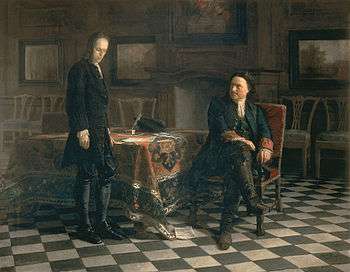
Peter the Great had two wives, with whom he had fourteen children; three of them survived to adulthood. Peter's mother selected his first wife, Eudoxia Lopukhina, with the advice of other nobles in 1689.[30] This was consistent with previous Romanov tradition by choosing a daughter of a minor noble. This was done to prevent fighting between the stronger noble houses and to bring in fresh blood to the family.[31] He also had a mistress from Germany, Anna Mons.[30]
Upon his return from his European tour in 1698, Peter sought to end his unhappy marriage. He divorced the Tsaritsa and forced her into joining a convent.[30] The Tsaritsa had borne Peter three children, although only one, the Tsarevich Alexei, had survived past his childhood.
He took Martha Skavronskaya as a mistress some time between 1702 and 1704.[32] Martha converted to the Russian Orthodox Church and took the name Catherine.[33] Though no record exists, Catherine and Peter are described as having married secretly between 23 Oct and 1 Dec 1707 in St. Petersburg.[34] Peter valued Catherine and married her again (this time officially) at Saint Isaac's Cathedral in Saint Petersburg on 9 February 1712.
His eldest child and heir, Alexei, was suspected of being involved in a plot to overthrow the Emperor. Alexei was tried and confessed under torture during questioning conducted by a secular court. He was convicted and sentenced to be executed. The sentence could be carried out only with Peter's signed authorization, and Alexei died in prison, as Peter hesitated before making the decision. Alexei's death most likely resulted from injuries suffered during his torture.[35] Alexei's mother Eudoxia had also been punished; she was dragged from her home and tried on false charges of adultery. A similar fate befell Peter's mistress, Anna Mons, in 1704.
In 1724 Peter had his second wife, Catherine, crowned as Empress, although he remained Russia's actual ruler. All of Peter's male children had died.
Issue
By his two wives, he had fourteen children. These included three sons named Pavel and three sons named Peter, all of whom died in infancy.
| Name | Birth | Death | Notes |
|---|---|---|---|
| By Eudoxia Lopukhina | |||
| Alexei Petrovich, Tsarevich of Russia | 18 February 1690[36] | 26 June 1718[36] | Married 1711, Princess Charlotte of Brunswick-Wolfenbüttel; had issue |
| Alexander Petrovich | 13 October 1691 | 14 May 1692 | |
| Pavel Petrovich | 1693 | 1693 | |
| By Catherine I | |||
| Peter Petrovich | 1704[36] | in infancy[36] | Born and died before the official marriage of his parents |
| Paul Petrovich | 1705[36] | in infancy[36] | Born and died before the official marriage of his parents |
| Catherine Petrovna | Dec 1706[36] | Jun 1708[36] | Born and died before the official marriage of her parents |
| Anna Petrovna | 27 January 1708 | 15 May 1728 | Married 1725, Karl Friedrich, Duke of Holstein-Gottorp; had issue |
| Yelisaveta Petrovna, later Empress Elizabeth | 29 December 1709 | 5 January 1762 | Reputedly married 1742, Alexei Grigorievich, Count Razumovsky; no issue |
| Maria Petrovna | 20 March 1713 | 27 May 1715 | |
| Margarita Petrovna | 19 September 1714 | 7 June 1715 | |
| Peter Petrovich | 15 November 1715 | 19 April 1719 | |
| Pavel Petrovich | 13 January 1717 | 14 January 1717 | |
| Natalia Petrovna | 31 August 1718 | 15 March 1725 | |
| Peter Petrovich | 7 October 1723 | 7 October 1723 | |
Death
In the winter of 1723, Peter, whose overall health was never robust, began having problems with his urinary tract and bladder. In the summer of 1724 a team of doctors performed surgery releasing upwards of four pounds of blocked urine. Peter remained bedridden until late autumn. In the first week of October, restless and certain he was cured, Peter began a lengthy inspection tour of various projects. According to legend, in November, at Lakhta along the Finnish Gulf to inspect some ironworks, Peter saw a group of soldiers drowning near shore and, wading out into near-waist deep water, came to their rescue.[37]
This icy water rescue is said to have exacerbated Peter's bladder problems and caused his death. The story, however, has been viewed with skepticism by some historians, pointing out that the German chronicler Jacob von Stählin is the only source for the story, and it seems unlikely that no one else would have documented such an act of heroism. This, plus the interval of time between these actions and Peter's death seems to preclude any direct link.
In early January 1725, Peter was struck once again with uremia. Legend has it that before lapsing into unconsciousness Peter asked for a paper and pen and scrawled an unfinished note that read: "Leave all to ..." and then, exhausted by the effort, asked for his daughter Anna to be summoned.[lower-alpha 2]
Peter died between four and five in the morning 8 February 1725. An autopsy revealed his bladder to be infected with gangrene.[6] He was fifty-two years, seven months old when he died, having reigned forty-two years.
Ancestors
| Ancestors of Peter the Great | ||||||||||||||||||||||||||||||||||||||||||||||||||||||||||||||||||||||||||||||||||||||||||||||||||||||||||||||||||||||||||||||||||||||||||||||||||||||||||||||||||||||||||||||||||||||||||||||||||||||||||||||||||||||||||||||||||||||||||||||||||||||||||||||||||||||||||||||||||||||||||||||||||||||||||||||||||||||||||||||||||||||||||||||||||||||||||||||||||
|---|---|---|---|---|---|---|---|---|---|---|---|---|---|---|---|---|---|---|---|---|---|---|---|---|---|---|---|---|---|---|---|---|---|---|---|---|---|---|---|---|---|---|---|---|---|---|---|---|---|---|---|---|---|---|---|---|---|---|---|---|---|---|---|---|---|---|---|---|---|---|---|---|---|---|---|---|---|---|---|---|---|---|---|---|---|---|---|---|---|---|---|---|---|---|---|---|---|---|---|---|---|---|---|---|---|---|---|---|---|---|---|---|---|---|---|---|---|---|---|---|---|---|---|---|---|---|---|---|---|---|---|---|---|---|---|---|---|---|---|---|---|---|---|---|---|---|---|---|---|---|---|---|---|---|---|---|---|---|---|---|---|---|---|---|---|---|---|---|---|---|---|---|---|---|---|---|---|---|---|---|---|---|---|---|---|---|---|---|---|---|---|---|---|---|---|---|---|---|---|---|---|---|---|---|---|---|---|---|---|---|---|---|---|---|---|---|---|---|---|---|---|---|---|---|---|---|---|---|---|---|---|---|---|---|---|---|---|---|---|---|---|---|---|---|---|---|---|---|---|---|---|---|---|---|---|---|---|---|---|---|---|---|---|---|---|---|---|---|---|---|---|---|---|---|---|---|---|---|---|---|---|---|---|---|---|---|---|---|---|---|---|---|---|---|---|---|---|---|---|---|---|---|---|---|---|---|---|---|---|---|---|---|---|---|---|---|---|---|---|---|---|---|---|---|---|---|---|---|---|---|---|---|---|---|---|---|---|---|---|---|---|---|---|---|---|---|---|---|---|---|---|---|---|---|
| ||||||||||||||||||||||||||||||||||||||||||||||||||||||||||||||||||||||||||||||||||||||||||||||||||||||||||||||||||||||||||||||||||||||||||||||||||||||||||||||||||||||||||||||||||||||||||||||||||||||||||||||||||||||||||||||||||||||||||||||||||||||||||||||||||||||||||||||||||||||||||||||||||||||||||||||||||||||||||||||||||||||||||||||||||||||||||||||||||
Popular culture

Peter has been featured in many books, plays, films, and games, including the poems The Bronze Horseman, Poltava and the unfinished novel Peter the Great's Negro, all by Alexander Pushkin. The former dealt with a The Bronze Horseman, an equestrian statue raised in Peter's honour. Alexey Nikolayevich Tolstoy wrote a biographical historical novel about him, named Pëtr I, in the 1930s.
- The 1922 German silent film Peter the Great directed by Dimitri Buchowetzki and starring Emil Jannings as Peter
- The 1937-1938 Soviet Union (Russia) film Peter the First
- The 1976 film Skaz pro to, kak tsar Pyotr arapa zhenil (How Tsar Peter the Great Married Off His Moor), starring Aleksey Petrenko as Peter, and Vladimir Vysotsky as Abram Petrovich Gannibal, shows Peter's attempt to build the Baltic Fleet.
- The 2007 film The Sovereign's Servant depicts the unsavoury brutal side of Peter during the campaign.
- Peter was played by Jan Niklas and Maximilian Schell in the 1986 NBC miniseries Peter the Great.
- A character based on Peter plays a major role in The Age of Unreason, a series of four alternate history novels written by American science fiction and fantasy author Gregory Keyes. Peter is one of many supporting characters in Neal Stephenson's Baroque Cycle – mainly featuring in the third novel, The System of the World.
- Peter was portrayed on BBC Radio 4 by Isaac Rouse as a boy, Will Howard as a young adult and Elliot Cowan as an adult in the radio plays Peter the Great: The Gamblers[38] and Peter the Great: The Queen of Spades,[39] written by Mike Walker and which were the last two plays in the first series of Tsar. The plays were broadcast on 25 September and 2 October 2016.
See also
- Government reform of Peter the Great
- History of the administrative division of Russia
- Russian battlecruiser Pyotr Velikiy, a Russian Navy battle cruiser named after Peter the Great
- History of Russia (1721–1796)
- Rulers of Russia family tree
- Peter the Great Statue
- Military history of the Russian Empire#Peter the Great modernization of the Russian history under Peter the Great
- List of people known as The Great
Notes
Footnotes
- ↑ Dates indicated by the letters "O.S." are in the Julian calendar with the start of year adjusted to 1 January. All other dates in this article are in Gregorian calendar (see Old Style and New Style dates).
- ↑ The 'Leave all ..." story first appears in H-F de Bassewitz Russkii arkhiv 3 (1865). Russian historian E.V. Anisimov contends that Bassewitz's aim was to convince readers that Anna, not Empress Catherine, was Peter's intended heir.
Citations
- ↑ Cracraft 2003.
- ↑ Лакиер А. Б. §66. Надписи вокруг печати. Соответствие их с государевым титулом. // Русская геральдика. — СПб., 1855
- ↑ Riasanovsky 2000, p. 214.
- 1 2 Riasanovsky 2000, p. 218.
- 1 2 Riasanovsky 2000, p. 216.
- 1 2 Hughes 2007, p. 179-182.
- ↑ Evgenii V. Anisimov, The Reforms of Peter the Great: Progress Through Violence in Russia (Routledge, 2015)
- ↑ Riasanovsky 2000, p. 221.
- ↑ Abbott, Peter (1902). "Peter the Great". Project Gutenberg online edition.
- ↑ Wes 1992, p. 14.
- ↑ Tavernier 2006, p. 349.
- ↑ Farquhar 2001, p. 176.
- ↑ Massie 1980, p. 191.
- ↑ Riasanovsky 2000, p. 220.
- ↑ "Russian Grand Priory — Timeline". 2004. Retrieved 9 February 2008.
- ↑ O.L. D'Or. "Russia as an Empire" (PHP). The Moscow News weekly. pp. , Russian. Retrieved 21 March 2008.
- ↑ Dmytryshyn 1974, p. 21.
- ↑ Oudard 1929, p. 197.
- ↑ Massie 1980, p. 453.
- 1 2 Riasanovsky 2000, p. 224.
- ↑ A History of the Modern World & R.R Palmer 1992, pp. 242–243
- ↑ Cracraft 2003, p. 37.
- ↑ Pipes 1974, p. 281.
- ↑ Palmer 1992, p. 245
- ↑ Dmytryshyn 1974, p. 10-11.
- ↑ Lee 2013, p. 31.
- ↑ Dmytryshyn 1974, p. 18.
- ↑ James Cracraft, The church reform of Peter the Great (1971).
- ↑ Lindsey Hughes, Russia in the Age of Peter the Great (1998) pp 332-56.
- 1 2 3 Hughes 2004, p. 134.
- ↑ Hughes 2004, p. 133.
- ↑ Hughes 2004, p. 131,134.
- ↑ Hughes 2004, p. 131.
- ↑ Hughes 2004, p. 136.
- ↑ Massie 1980, p. 76,377,707.
- 1 2 3 4 5 6 7 8 Hughes 2004, p. 135.
- ↑ Nisbet 1905.
- ↑ BBC Radio 4 - Drama, Tsar, Peter the Great: The Gamblers
- ↑ BBC Radio 4 - Drama, Tsar, Peter the Great: Queen of Spades
References
- Anisimov, Evgenii V. (2015) The Reforms of Peter the Great: Progress Through Violence in Russia (Routledge)
- Bain, R. Nisbet (1905). Peter the Great and his pupils. Cambridge University. Retrieved 9 February 2008.
- Bushkovitch, Paul (2003). Peter the Great. Rowman and Littlefield. ISBN 0847696391.
- Bushkovitch, Paul (2001). Peter the Great: The Struggle for Power, 1671–1725. Cambridge University Press.
- Bushkovitch, Paul A. (January 1990). "The Epiphany Ceremony of the Russian Court in the Sixteenth and Seventeenth Centuries". Russian Review. 49 (1): 1–17. doi:10.2307/130080. JSTOR 130080.
- Cracraft, James (2003). The Revolution of Peter the Great. Harvard University Press.
- Dmytryshyn, Basil (1974). Modernization of Russia Under Peter I and Catherine II. Wiley.
- Farquhar, Michael (2001). A Treasure of Royal Scandals. New York: Penguin Books. ISBN 0-7394-2025-9.
- Graham, Stephen. Peter the Great: A Life of Peter I of Russia called The Great.
- Grey, Ian (1960). Peter the Great: Emperor of All Russia.
- Hughes, John R (2007). "The seizures of Peter Alexeevich". Epilepsy & Behavior. 10 (1): 179–182. doi:10.1016/j.yebeh.2006.11.005.
- Hughes, Lindsey (2004). "Catherine I of Russia, Consort to Peter the Great". In Campbell Orr, Clarissa. Queenship in Europe 1660-1815: The Role of the Consort. Cambridge University Press. pp. 131–154. ISBN 0-521-81422-7.
- Hughes, Lindsey (1998). Russia in the Age of Peter the Great. Yale University Press. ISBN 0-300-08266-5.
- Hughes, Lindsey (2001). Peter the Great and the West: New Perspectives. Palgrave Macmillan. ISBN 0-333-92009-0.
- Hughes, Lindsey (2002). Peter the Great: A Biography. Yale University Press. ISBN 0-300-10300-X.
- Lee, Stephen J. (2013). Peter the Great. Routledge.
- Massie, Robert K. (1980). Peter the Great: His Life and World. New York: Alfred A. Knopf. ISBN 978-0-307-29145-5., a popular biography
- Oudard, Georges; Atkinson, Frederick (translated) (1929). Peter the Great. New York: Payson and Clarke. Cite uses deprecated parameter
|coauthors=(help) - Pipes, Richard (1974). Russia under the old regime.
- Raeff, Mafrc, ed. (1963). Peter the Great, Reformer or Revolutionary?.
- Riasanovsky, Nicholas (2000). A History of Russia (6th ed.). Oxford: Oxford University Press.
- Tavernier, Roger (2006). Russia and the Low Countries: An International Bibliography, 1500–2000. Barkhuis. p. 349. ISBN 978-90-77089-04-0.
- Troyat, Henri (1987). Peter the Great. New York: E.P. Dutton. ISBN 0-525-24547-2.
- Wes, Martinus A. (1992). Classics in Russia, 1700–1855: Between Two Bronze Horsemen. Brill. ISBN 978-90-04-09664-6.
- Zitser, Ernest A (Spring 2005). "Post-Soviet Peter: New Histories of the Late Muscovite and Early Imperial Russian Court". Kritika: Explorations in Russian and Eurasian History. 6 (2): 375–392. doi:10.1353/kri.2005.0032.
In Russian
- (Russian) Brickner Alexander Gustavovich. (1902–1903) An Illustrated History of Peter the Great (Иллюстрированная история Петра Великого) at Runivers.ru in DjVu and PDF formats
Further reading
- Anderson, M. S. "Russia under Peter the Great and the changed relations of East and West." in J.S. Bromley, ed., The New Cambridge Modern History: VI: 1688-1715 (1970) pp 716–740.
- Anisimov, Evgenii V. The Reforms of Peter the Great: Progress through Coercion in Russia (1993) online
- Bushkovitch, Paul. Peter the Great: The Struggle for Power, 1671-1725 (2001) online
- Cracraft, James. The Revolution of Peter the Great (2003) online
- Raef, Mark, ed. Peter the Great, Reformer or Revolutionary? (1963) excerpts from scholars and primary sources online
- Schimmelpenninck van der Oye, David, and Bruce W. Menning, eds. Reforming the Tsar's Army - Military Innovation in Imperial Russia from Peter the Great to the Revolution (Cambridge UP, 2004) 361 pp. scholarly essays
External links
- Romanovs. The third film. Peter I, Catherine I on YouTube – Historical reconstruction "The Romanovs". StarMedia. Babich-Design(Russia, 2013)
Further reading
| Wikiquote has quotations related to: Peter the Great |
| Wikimedia Commons has media related to Peter the Great. |
 Bain, Robert Nisbet (1911). "Peter I.". In Chisholm, Hugh. Encyclopædia Britannica. 21 (11th ed.). Cambridge University Press. pp. 288–291.
Bain, Robert Nisbet (1911). "Peter I.". In Chisholm, Hugh. Encyclopædia Britannica. 21 (11th ed.). Cambridge University Press. pp. 288–291.
| Regnal titles | ||
|---|---|---|
| Preceded by Feodor III |
Tsar of Russia 1682–1721 with Ivan V |
Russian Empire |
| New title | Emperor of Russia 1721–1725 |
Succeeded by Catherine I |
| Preceded by Frederick |
Duke of Estonia and Livonia 1721–1725 | |
.jpg)
.svg.png)
.svg.png)

